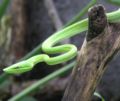- Oxybelis fulgidus
-
Green Vine Snake 
A Green Vine Snake in Yasuni National Park Scientific classification Kingdom: Animalia Phylum: Chordata Class: Sauropsida Order: Squamata Suborder: Serpentes Family: Colubridae Genus: Oxybelis Species: O. fulgidus Binomial name Oxybelis fulgidus
(Daudin, 1803)Synonyms Coluber fulgidus Daudin, 1803
Dryophis fulgidus Fitzinger, 1826The Green Vine Snake, Oxybelis fulgidus, is a long, slender arboreal Colubrid snake that inhabits Central America and northern South America.
Contents
Description
This snake is slender, about 2 cm thick, and may have a length of about 1.5 to 2 meters. The tail is long and very delicate, but mostly used to hold on while reaching for prey. The head is aerodynamically-shaped and very pointy, the mouth is very big and extends almost through the whole head. The tongue is long and green, when in use it is kept outside and moved up and down.
Catching Prey
The green vine snake stays high on trees and looks down to the ground. When a mouse, lizard or nest is found the snake follows the prey a short distance and smells it carefully. If the snake is content with it, it bites into the head and lifts the prey 20–40 cm from the ground. With this the snakes prevents the prey from using its physical strength. The vine snake has two larger teeth at the back of its mouth; these teeth permit the toxic saliva to penetrate the wounds and to immobilize the prey. Then it is rapidly swallowed. Once the prey is completely in the snakes body, the vine snake searches for a resting place, usually in the highest point of a tree.
Behavior in Captivity
Vine snakes must be kept in large terrariums with a height of at least 2 meters and a surface of 6-16 square meters. The behavior towards humans is neutral and the snake usually goes to the other end of the terrarium. Some adapt very well and even come nearer. These are almost entirely lizard eaters. It is possible to train them to eat mice but difficult.
Images
References
Categories:- Colubrids
- Reptiles of Central America
- Reptiles of South America
Wikimedia Foundation. 2010.





